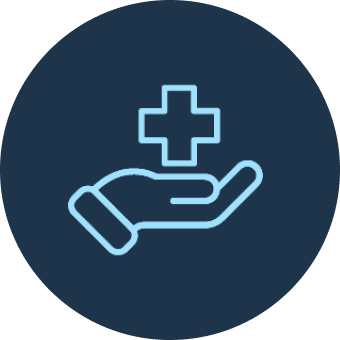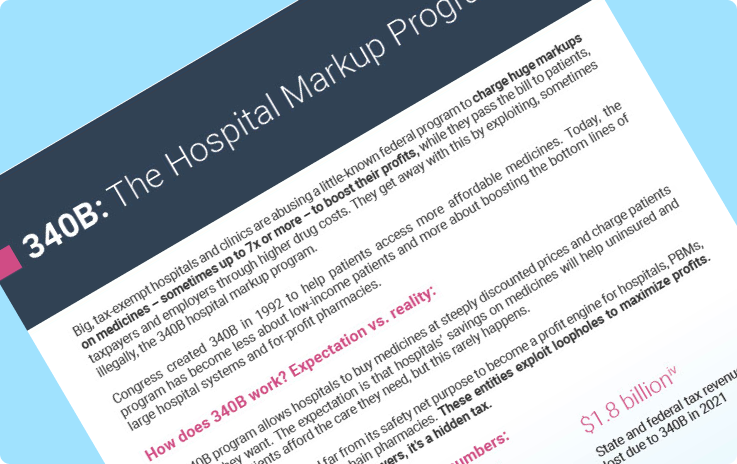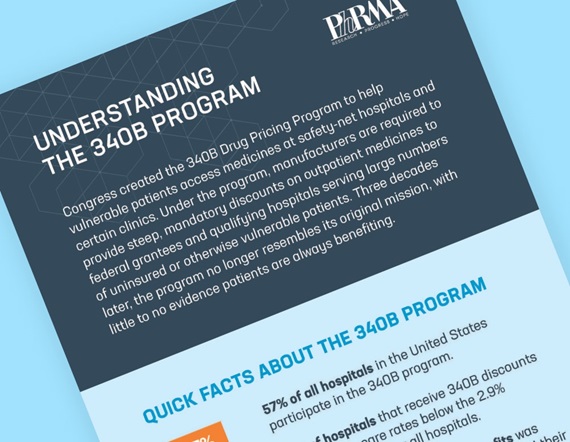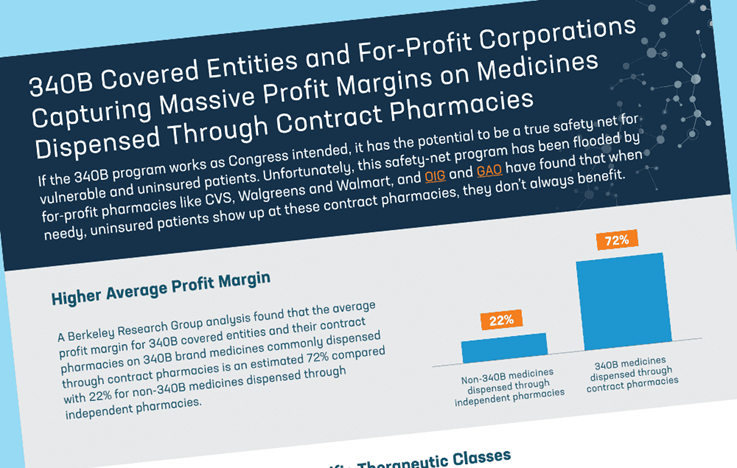The 340B Hospital
Markup Program


Overview What is 340B?
Big, tax-exempt hospitals and clinics abuse a little-known federal program to charge huge markups on medicines, sometimes up to 7x or more, to boost their profits, while they pass the bill to patients, taxpayers and employers through higher drug costs.
They get away with this by exploiting, sometimes illegally, the 340B hospital markup program. This government program was created in 1992 to help patients access more affordable medicines. Today, the 340B program has become less about patients and more about boosting the bottom lines of hospitals and for-profit pharmacies.
Here’s how.
The 340B program allows hospitals and clinics to buy medicines at steep discounts and charge patients whatever they want, with the expectation that savings will help uninsured and low-income patients afford the care they need. Unfortunately, this often doesn’t happen.
Without oversight, 340B has strayed far from its safety net purpose to a profit engine for hospitals, PBMs, private equity firms, and big chain pharmacies. These entities exploit loopholes to maximize profits, while patients, taxpayers, and employers bear the hidden costs through inflated drug prices.
Profits from 340B markups now account for nearly $65 billion – 10% of brand medicine spending – and continue to grow unchecked. Worse, hospitals can charge full price to vulnerable patients, burying them in medical debt if they can’t pay.
When hospitals have free rein to mark up medicines, everyone pays the price. It’s time for transparency and accountability to stop this greedy behavior.

Locations Where is 340B?
340B hospitals and their many contract pharmacies are found in every state. How much charitable care are 340B hospitals in your state providing as compared to the national average? Are 340B hospitals in your state contracting with local pharmacies, or are they profiting from contracts with pharmacies nationwide? Explore the interactive map below and select a state to access state-specific data on 340B.

PBM Profit Engine How Did 340B Become a PBM Giveaway?
Hospitals that participate in the 340B program contract with pharmacies to dispense the program’s drug prescriptions. Today there are over 33,000 distinct pharmacies participating in the program, known as contract pharmacies. While one might expect to find 340B contract pharmacies located in medically underserved neighborhoods to help vulnerable patients access medicines, that isn’t the case. Studies have found the exponential growth in contract pharmacies from 2011 to 2019 was concentrated in affluent communities, and not in lower-income areas with high unmet need.
Because of consolidation in the supply chain, PBMs now own the majority of pharmacies nationwide and make the largest share of their profits (55%) from their pharmacy business. They use the 340B program to drive that profit. There are more than 94,000 contracts between a 340B provider and a pharmacy with financial ties to one of the three largest PBMs — CVS Health, Express Scripts and OptumRx. More than 50 cents of each $1 in profits contract pharmacies receive through the 340B program go to just four PBM and pharmacy companies.
These for-profit entities and their affiliates have found their way into the 340B program to capture profits that could otherwise have been used to lower drug costs for low-income and vulnerable patients.
Areas for 340B Reform What’s the Solution?
The 340B program lacks guardrails for how 340B profits can be used or oversight to where the money is going. This enables large, wealthy hospitals and chain pharmacies to exploit the program for profit, often at the expense of patients.
An analysis published in the New England Journal of Medicine found no evidence hospitals invest their 340B profits into safety-net care. Similarly, a study published in the Journal of the American Medical Association concluded: “Nonetheless, our work adds to a growing body of evidence questioning the degree to which 340B program growth serves vulnerable communities.”
If the money isn’t going to help patients, where is it going?
Here are some ways Congress can fix 340B.

Ensure Benefits Reach Low-income Patients
All hospitals in the program and their contract pharmacies should be required to pass through 340B discounts to reduce the cost of medicines for low-income and vulnerable patients. Further, Congress needs to clarify in the law who is an eligible “patient” to help ensure the benefits of 340B are reaching those patients. There are currently zero patient protections and zero requirements for how hospitals use 340B discounts to help patients afford their medicines, enabling large hospital systems, chain pharmacies and pharmacy benefit managers (PBMs) to generate massive profits without commensurate growth in access and affordability for patients most in need.



